Politics in Estonia takes place in a framework of a parliamentary representative democratic republic, whereby the Prime Minister of Estonia is the head of government, and of a multi-party system. Legislative power is vested in the Estonian parliament. Executive power is exercised by the government, which is led by the prime minister. The judiciary is independent of the executive and the legislature. Estonia is a member of United Nations, the European Union, and NATO.
The Estonian resistance movement was an underground movement to resist the occupation of Estonia by Nazi Germany, 1941–1944 during World War II. Due to the unusually benign measures implemented in Estonia by the German occupation authorities, especially in contrast to the preceding harsh Soviet occupation of Estonia (1940–1941), the movement was slower to develop effective tactics on a wide scale than in other occupied countries.

The Estonian Police was the law enforcement agency of Estonia. It was subordinate to the Ministry of the Interior. In 2010, the organization was superseded by the Police and Border Guard Board.

The Ministry of Defence of the Republic of Estonia and its head, the Minister of Defence, are responsible for organizing national defence. It is Estonia's ministry of defence. The mission of the Ministry of Defence is to deter attacks against Estonia and ensure that the country is capable of defending itself against external threats. Estonian national defence is based on initial self-defence capability as well as membership in NATO.

The Estonian Defence Forces are the unified military forces of the Republic of Estonia. The Estonian Defence Forces consist of the Estonian Land Forces, the Estonian Navy, the Estonian Air Force, and the paramilitary Estonian Defence League. The national defence policy aims to guarantee the preservation of the independence and sovereignty of the state, the integrity of its land area, territorial waters, airspace and its constitutional order. Its main goals remain the development and maintenance of a credible capability to defend the nation's vital interests and development of the defence forces in a way that ensures their interoperability with the armed forces of NATO and European Union member states to participate in the full range of missions for these military alliances.

The International Organization of Supreme Audit Institutions (INTOSAI) is an intergovernmental organization whose members are supreme audit institutions. Nearly every supreme audit institution in the world is a member of INTOSAI. Depending on the type of system used in their home country, the members of INTOSAI may be variously titled the Chief Financial Controller, the Office of the Comptroller General, the Office of the Auditor General, the Court of Accounts, or the Board of Audit.

The Police and Border Guard Board is a unified national governmental agency within the Estonian Ministry of Interior and is responsible for law enforcement and internal security in the Republic of Estonia.
Corporate chambers were a series of corporate institutions in Estonia during the interwar period. The first of these – the Chamber of Commerce and Industry – was created in 1924, and the second, the Chamber of Agriculture, followed in 1931. However, most of the chambers were established after the 1934 coup d'état of Konstantin Päts, and the Era of Silence which followed the coup became their heyday.
A supreme audit institution is an independent national-level institution which conducts audits of government activities. Most supreme audit institutions are established in their country's constitution, and their mandate is further refined in national legislation. Supreme audit institutions play an important role in providing oversight and accountability in a country by monitoring the use of public funds and reviewing the quality and accuracy of government financial reporting. They also contribute to anti-corruption efforts. Depending on the country, a supreme audit institution may be called a court of audit, auditor-general or the board of audit. Nearly every supreme audit institution in the world is a member of the International Organization of Supreme Audit Institutions, which works to establish and disseminate international standards and good practices.

The Headquarters of the Estonian Defence Forces is the working body of the Commander of the Estonian Defence Forces and joint staff of the Estonian Defence Forces. Its main tasks include supporting the activities of the Commander and Deputy Commander of the Defence Forces; planning the activities of the Defence Forces; advising, supervising, coordinating and controlling the activities of the Defence Forces units.
The State Audit Office of the Republic of Latvia is a public auditing body overseeing the finances of national and local government in Latvia. It was first created in 1918, and re-established in 1992 when Latvia again became independent.
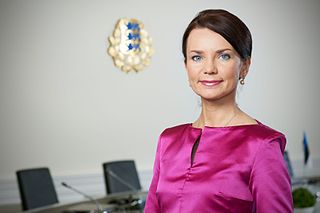
Minister of Finance is the senior minister at the Ministry of Finance (Rahandusministeerium) in the Estonian Government. The Minister is one of the most important members of the Estonian government, with responsibility for coordinating the government's policies on national finances. The position was originally established in 1918.

Miina Härma Gymnasium is an institution composed of a primary school and a secondary school in Tartu, Estonia. The school holds a special emphasis on languages. Miina Härma Gymnasium is an IB World School offering the Diploma Programme and the Primary Years Programme, and a candidate school for the Middle Years Programme.
This is a list of members of the fifth legislative session of the Estonian Parliament (Riigikogu) following the 1932 elections. It sat between 15 June 1932 and 2 October 1934, when its activities were suspended. The session formally ended on 31 December 1937.
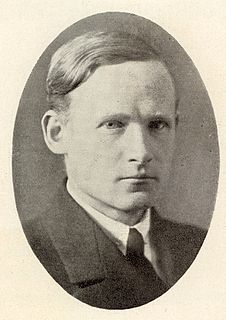
Aleksander Ferdinand Oinas was an Estonian politician; he was a long-serving member of the Estonian Parliament (Riigikogu) and served three times as a government minister. was an Estonian politician; he was a long-serving member of the Estonian Parliament (Riigikogu) and served three times as a government minister.
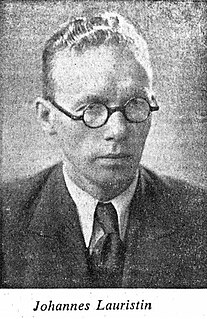
Johannes Lauristin was an Estonian communist politician, activist, writer and statesman who served as the first Chairman of the Council of People's Commissars of the Estonian Soviet Socialist Republic. Hs wife was communist politician Olga Lauristin and his daughter was politician Marju Lauristin.
The Auditor-General of Ghana is the head of the Ghana Audit Service, a legislative branch agency re-established by the government of Ghana in 1992 through the 1992 Constitution of Ghana. It was established as part of the Audit Service through Article 188 of the 1992 Constitution of Ghana as part of the Public Services of Ghana. The Auditor-General through the Audit service undertakes audits of the public accounts of Ghana and all public offices as mandated by Article 187 of the 1992 Constitution of Ghana.

Janar Holm is an Estonian civil servant.
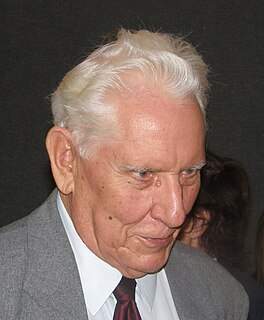
Hindrek-Peeter Meri was an Estonian statesman.
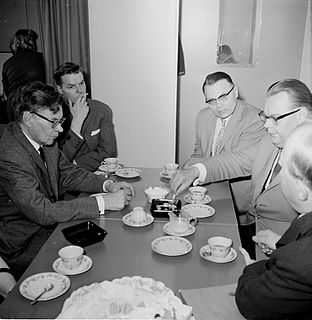
Felix Johannes Oinas was an Estonian folklorist, linguist, and translator.












